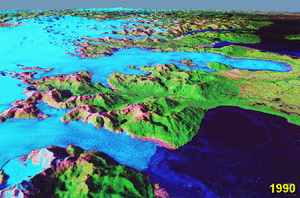San Rafael Glacier facts for kids
Quick facts for kids San Rafael Glacier |
|
|---|---|
 |
|
| Location | Chile |
| Coordinates | 46°42′S 73°50′W / 46.700°S 73.833°W |
| Area | 760 km2 (290 sq mi) |
| Terminus | Proglacial lake |
The San Rafael Glacier is a huge river of ice found in southern Chile. It is one of the main glaciers that flows out from the Northern Patagonian Ice Field. This glacier is very special because it is the closest tidewater glacier to the equator. This means it's a glacier that reaches the ocean (or a lake connected to the ocean) and is found closer to the middle of the Earth than most other tidewater glaciers.
The San Rafael Glacier ends by breaking off into the beautiful Laguna San Rafael. This whole area is protected as part of the Laguna San Rafael National Park.
Contents
What is a Glacier?
A glacier is like a very slow-moving river made of ice. It forms over many years when snow falls in one place and doesn't melt. Instead, it gets packed down by more snow falling on top. This pressure turns the snow into solid ice.
Glaciers move because of gravity. They slowly slide downhill, carving out valleys and shaping the land as they go. They can be found in high mountains or near the Earth's poles.
Where is the San Rafael Glacier Located?
The San Rafael Glacier is in the Aysén Region of southern Chile. It's part of a huge ice mass called the Northern Patagonian Ice Field. This ice field is one of the largest outside of the polar regions.
The glacier flows through a stunning landscape of mountains, forests, and water. Its remote location makes it a unique natural wonder.
Why is the San Rafael Glacier Special?
This glacier stands out for a few reasons:
- Closest to the Equator: It is the tidewater glacier found closest to the equator. This is unusual because glaciers usually need very cold temperatures to survive, which are more common far from the equator.
- Calving into a Lake: The glacier "calves" into Laguna San Rafael. Calving is when large pieces of ice break off the end of a glacier and fall into the water, creating icebergs. This is a dramatic and noisy process that visitors often come to see.
- Part of a National Park: The glacier is inside Laguna San Rafael National Park. This park is a UNESCO Biosphere Reserve, meaning it's a special place recognized for its unique nature and importance to the planet.
Laguna San Rafael National Park
Laguna San Rafael National Park was created in 1959. It covers a huge area of about 17,420 square kilometers (6,726 square miles). The park protects a mix of landscapes, including:
- High mountains
- Deep fjords (long, narrow inlets of the sea)
- Dense forests
- And, of course, the San Rafael Glacier and the Northern Patagonian Ice Field.
The park is home to many types of wildlife. You might see sea lions, dolphins, and various seabirds. The plant life is also very rich, with ancient forests that have grown for centuries.
The Future of the Glacier
Like many glaciers around the world, the San Rafael Glacier is changing. Scientists study it to understand how glaciers respond to changes in climate. Observing glaciers like San Rafael helps us learn more about our planet's environment.
See also
 In Spanish: Glaciar San Rafael para niños
In Spanish: Glaciar San Rafael para niños
- List of glaciers


